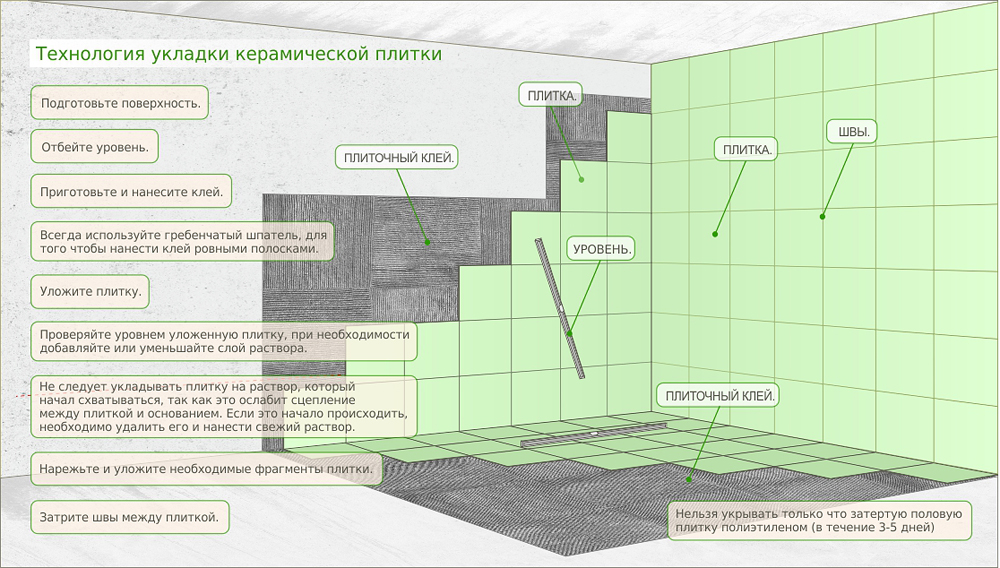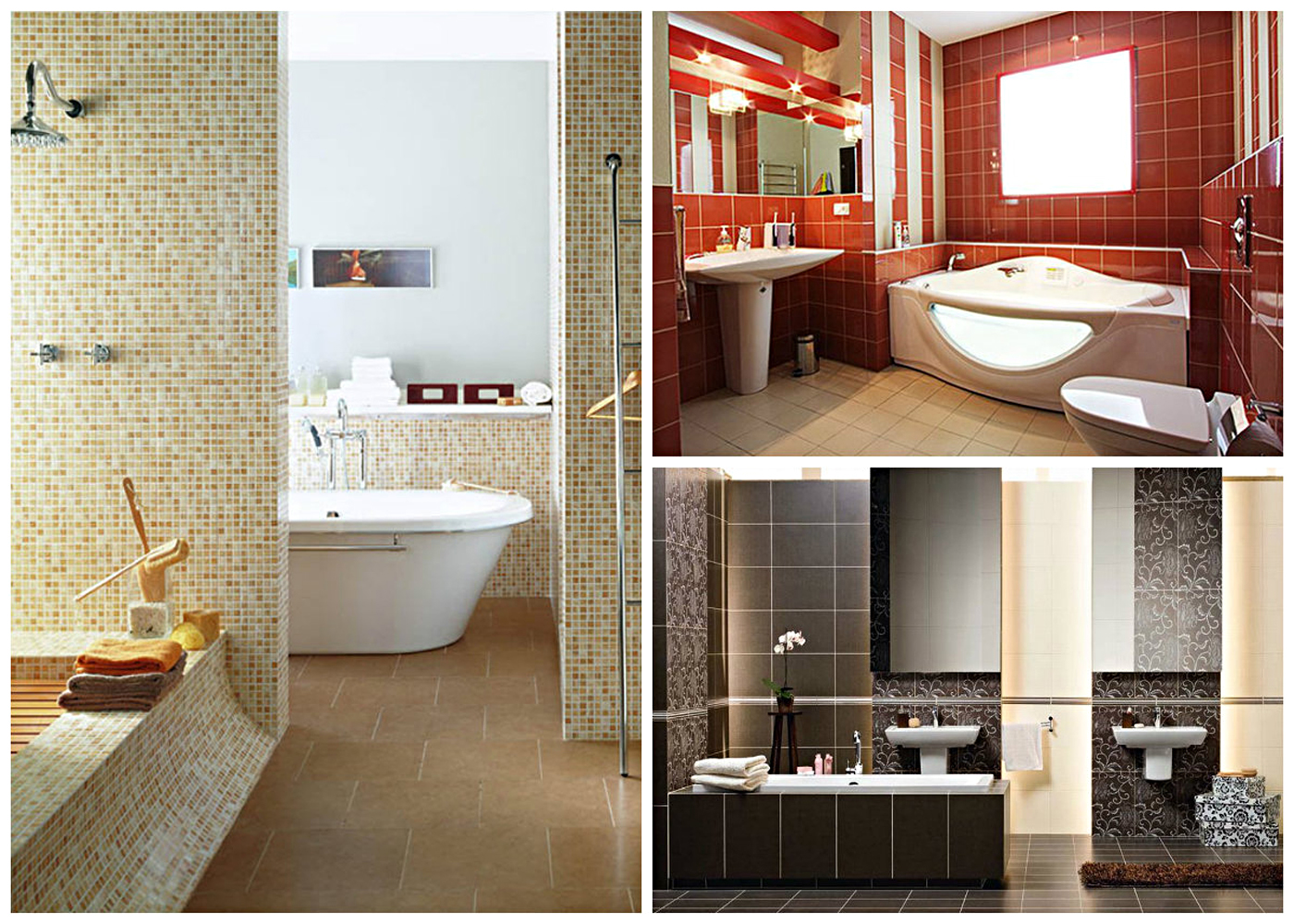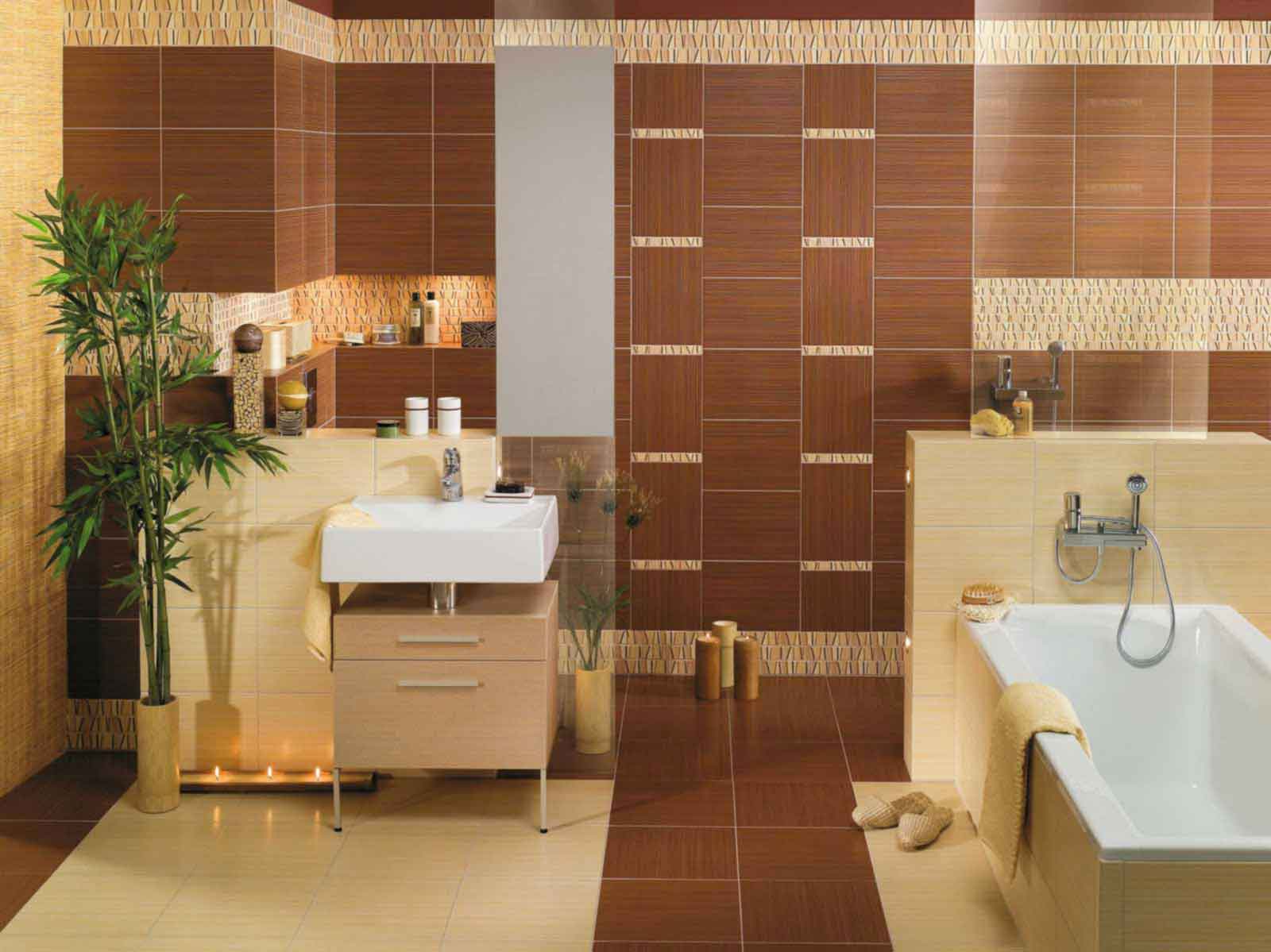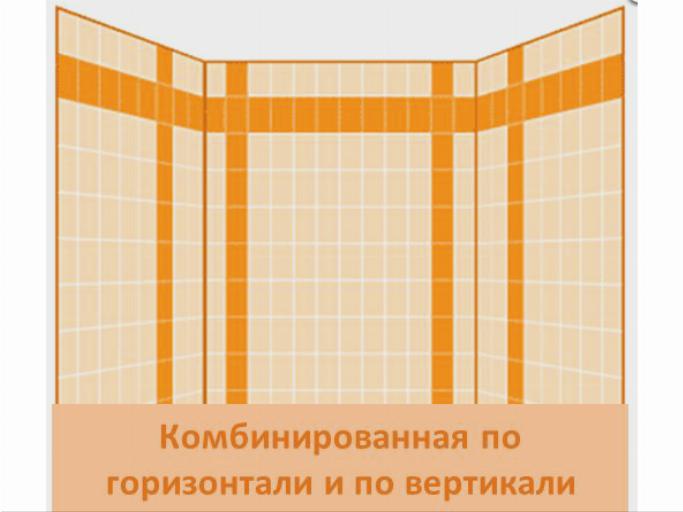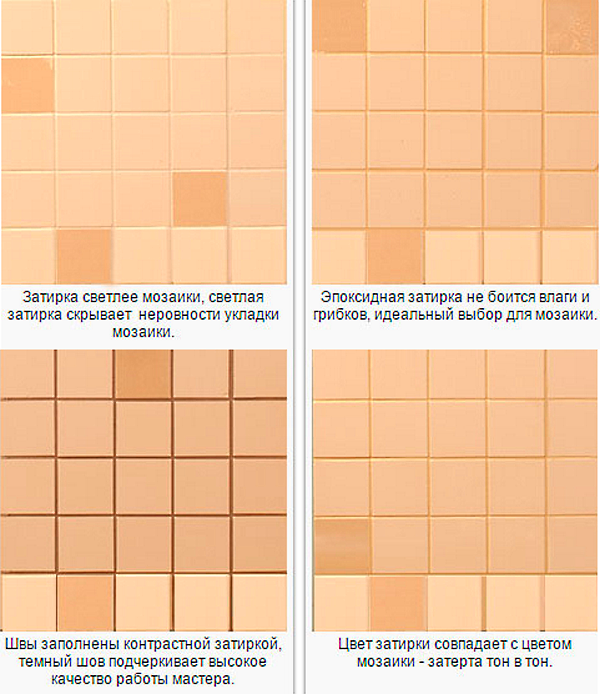How to choose the shape and size of the tiles
Most often, stores offer square or rectangular tiles. If you're doing your own repairs, stick with these classic options. It is much more convenient to work with them than with tiles of an unusual shape.
Want to achieve different visual effects? Use rectangular tiles. Place it vertically on the walls, and you will stretch them in length, horizontally - in width. To visually expand the room, lay the floor tiles diagonally.
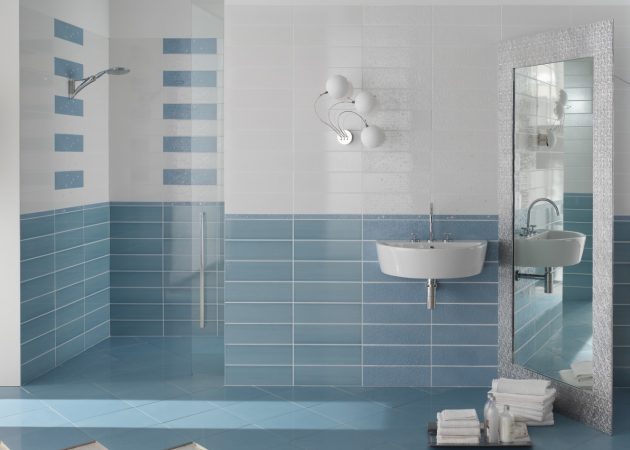

Do not choose very small tiles for small spaces. Also give up the idea of decorating the room in a mosaic style. It narrows the space a lot. Do not use very large tiles. With it, there will be large seams on the walls, which will also be unprofitable to divide the room into parts.
Avoiding extremes is also worth it for reasons of economy.
Determine the amount of material. Method # 1
The first indicators are achieved by multiplying the length by the width and are removed from the floor area. By analogy, the area of one tile product is calculated, and the data obtained is rounded up.
Having received two approximate numbers, the floor area is divided by the area of the ceramic, and the resulting value is rounded up to a larger integer. Thus, we have a certain number to which we need to add 5%, i.e. multiply by 1.05, and round the result up.

For clarity, you need to calculate using an example, where we take the average data. The original ceiling is 2.70 m, the walls are 1.9 and 2.0 m, the width of the door is 0.7 m.If the conventional dimensions of the floor tiles are 35 by 35 cm, then the calculation will be as follows:
- 1.9 * 2.0 = 3.8 m2;
- 0.35 * 0.35 = 0.1225 m2;
- 3.8 m2 / 0.1225 m2 = 31 pcs.;
- 31 * 1.05 = 32.55, which means you need about 33 tiles.
Method # 2
The number of ceramic items that will be laid on the floor is calculated by length and width. To do this, you need to divide each of these floor parameters by the same tile value. The obtained data are multiplied, after which we round them up and add 5% again. Here's a rough calculation:
- 1.9 / 0.35 = 5.42 pcs.;
- 2.0 / 0.35 = 5.71 pcs.;
- 5.42 * 5.71 = 30.96 pcs.;
- 31 * 1.05 = 32.55, i.e. you need about 33 tiles.
 Bathroom tile layout plan
Bathroom tile layout plan
Collections
When you come to any specialty store, you will see samples of bathroom tiles (collections) that hang on the stands. A collection is a collection of tiles that are combined in size, shape and color.
The standard collection consists of 5 elements:
- Light background,
- dark background,
- border (frieze),
- decor,
- floor tiles.
One collection of bathroom tiles can have several color options. In practice, in one room it will be enough to correctly combine one light and one dark background, take one type of decors and floor tiles.
Most of the collections have the same size for backgrounds and decor. The curb is the same in length, but much less in height. The floor tiles are in the shape of a square, with sides greater than the height of the main elements, but less than their length. Sometimes the length of the square is equal to the length of the main tile.
Manufacturers and prices
The very first thing worth paying attention to is the country of origin. Bathroom tiles can be made in France, Germany, Spain, Italy, Portugal or Russia
If you do not want to have problems during installation due to large differences in the size and shape of the tiles in the package, then it is better to immediately abandon Russian tiles.
In some stores, the tiles on the stands are specially cut to make them seem even at first glance.
There are several manufacturers in each country. But do not be guided by the name of the company, as each of them has good and bad collections of bathroom tiles.
A good tile for a bath now costs from 900 to 1700 rubles per square meter. For this price, you will receive high-quality and beautiful tiles, but do not overpay for the brand. If you are making repairs for a long time and for yourself, then you can buy more expensive options, but not cheaper.
Surface
As a rule, bathroom floor tiles are matte and wall tiles are glossy.The glossy finish looks brighter and richer, and is easier to clean. But if you cover the floor with a glossy material, it will be slippery and over time the paint layer will wipe off, and bald spots will appear.
The most practical is the texture of a mosaic tile, when its parts are uneven, and at a slight inclination relative to adjacent elements and have a slightly different shade. Outwardly, it looks like pixels.
Mosaic tiles from Kerlife (Spain), Mosaic Lux collection
- Light drops from detergents;
- Dark drops from dirty water;
- Toothpaste drops.
At the same time, the dirt on it is invisible, it is easily washed off, and all this is not to the detriment of the beauty of the coating. But if the sizes of the squares are too large, the corner elements and plumbing will not adhere to such a relief surface.
Dimensions (edit)
As for choosing the optimal size, the larger the bathroom tiles, the better, but this should be within reasonable limits. Imagine what a 90 cm tile for a small bathroom 160 cm wide will look like.In addition, you will not be able to make a correctly hidden hatch due to the fact that it must be installed under the full tile, you will need to somehow fix this whopper and open it.
Optimal dimensions for most bathrooms:
- 60*20,
- 50*20,
- 50*25,
- 60*30,
- 45*20.
Large-format seamless porcelain tiles for bathrooms and seamless tiles are not suitable for several reasons. Firstly, it is very large for most bathrooms. Secondly, it is impossible to attach it to hidden hatches.
Why you shouldn't use curbs
Imagine how difficult it will be to cut such a raised border with glued beads and what kind of joint in the inner corner it will turn out
Ceramic curbs are now almost never used for installation.
They were originally used to get rid of narrow trims due to fixed ceiling heights. But now you can install a suspended or stretch ceiling with any offset from the main one, and this problem will disappear by itself.
Also, the border was often used to separate light and dark backgrounds. But after furnishing the room, this belt turns out to be torn, and the beautiful effect is lost.
In addition, it is very difficult to correctly guess the height of the embossed curb on the wall, so that it does not overlap the places where the hanging plumbing fixtures fit, does not visually draw attention to itself and does not create a narrow trim above the bathroom
Detailed calculation: sketching
For a detailed calculation, you will need a sketch of the bathroom. To compose it, you need to consider:
- what kind of tile pattern will be on the surfaces;
- places without tiles (for example, behind the bathroom);
- layout option.
Most popular tile designs:
- One type of tile, no decor.
- Vertical and horizontal stripes.
- Chaotic inserts of piece decor on a tiled background.
- Using a ready-made panel.
- Splitting walls into color blocks (for example, the top of one shade, the bottom of another).
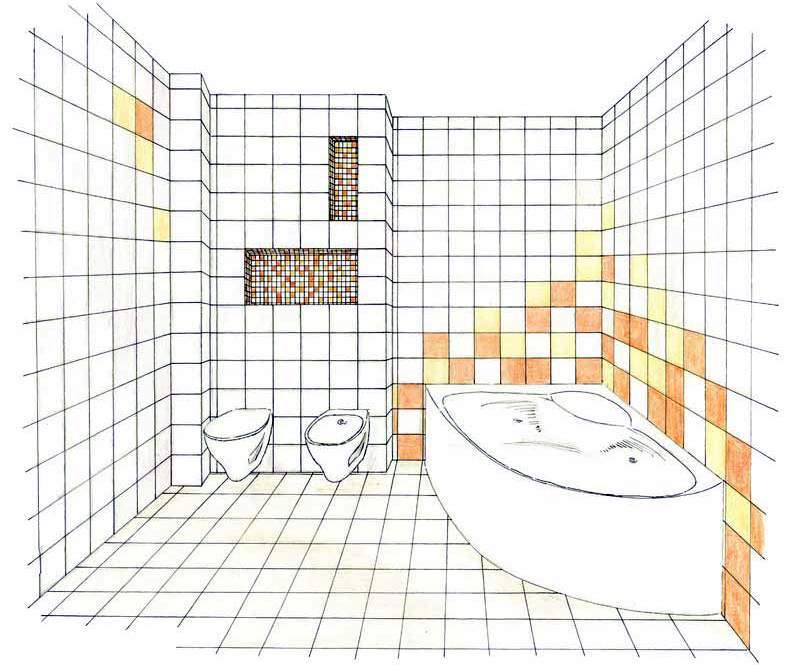
Points to be missed when laying tiles:
- behind the bathroom;
- behind furniture;
- behind the mirrors. Especially if only a mirror sheet is planned, which is usually glued to an unlined surface.
How to choose a tile material
The tiles can be made from various materials, which helps each person to choose the best option.
Ceramics
This is the most popular option and is made from fired and molded clay. There are several types of surfaces. They are smooth and rough. Regardless of the characteristics of such a tile, it is durable, tolerates moisture normally and is unpretentious in maintenance. The key disadvantage is fragility. A pinpoint impact may crack the finish.
Faience
This is one of the well-known varieties of the currently popular ceramic tiles. It is made from a substance of white clay, which is distinguished by its strength and plasticity. Faience tiles are considered to be of the highest quality. This material is obtained by pressing and double firing.During the production process, refractory substances are placed in the clay.
Faience tiles are characterized by high cost and beautiful decor. Therefore, it is often used for wall cladding.
Majolica
This material is also expensive. Its characteristic feature is considered to be excellent resistance to high temperatures. This tile is made from red clay using pressing and double firing. Moreover, its cost is high. This is due to the fact that majolica is decorated with hand-painted paintings. To preserve the pattern, this decor is used as an additional decoration in the driest parts of the room.

Gres
These tiles are made from red and white clay. It is obtained by pressing and subsequent firing. Although there is no glaze on the material, it practically does not absorb moisture. This is due to the increased texture density. At the same time, the tile weighs a lot.
Clinker
This material is characterized by low porosity. This achieves amazing texture strength. Moreover, such tiles are often distinguished by natural shades. Therefore, it is not used for bold design experiments.
Porcelain stoneware
This material is characterized by all the advantages of tiles and granite. The composite material is highly durable and can serve for at least 50 years. It is characterized by high moisture resistance. In addition, the material is not exposed to aggressive chemicals.
Rectified
Tiles and porcelain stoneware are rectified. This term is understood as a special way of cutting, which helps to get perfectly smooth borders. This type of tile appeared relatively recently, but has already gained high popularity.
Tiled
Such tiles are made from the simplest components - water and clay. Therefore, this material is considered environmentally friendly. It does not burn or electrify.

Laying methods
For flooring, namely tiles on the floor in the bathroom, various methods can be used, of which there are a huge number. Most often, you can find the option of staggering at an angle of 90 degrees with an interval of half a tile. A similar option is the tile laying angle of 45-60 degrees, but in an oblique direction relative to the entrance to the room. These methods will allow you to get an answer to the question of which tile is best for a small bathroom in order to increase the area and size in visual perception.
If you already start working, then you need to know how to lay tiles in a small bathroom. When buying, you can present the collection in one form or another, combine them with each other to achieve the desired result. In a separate room, the same tile can look completely different.
Layout schemes for tiles on the walls
When decorating walls with tiles, the following basic rules must be observed:
- layout from the middle of the wall to the corners;
- the size of the cut tile is greater than or equal to half of the whole tile;
- the same size of cut cladding along the edges of the wall;
- either a complete coincidence of the seams on the walls, floor, or their complete mismatch.
 Matching floor and wall seams. There is not much visual benefit from such a coincidence, but the complexity increases.
Matching floor and wall seams. There is not much visual benefit from such a coincidence, but the complexity increases.
With respect to the vertically drawn line, which is the middle of the wall, the tile can be in two positions - adjoining by the edge, overlapping with the alignment of the center of the wall cladding.
Depending on the ratio of the dimensions of the wall and tiles, a wide, beautiful cut in the abutments to adjacent walls can turn out in either case, as in the diagram below.
 Two options for the layout of the tile from the middle of the wall to the left and right.
Two options for the layout of the tile from the middle of the wall to the left and right.
Square tiles are laid with a mesh (vertical and horizontal seams are aligned with each other).

Facing "hog" most often imitates brickwork with dressing in adjacent rows for half the length.
 Design cladding "hog".
Design cladding "hog".
Rectangular tiles are laid vertically or horizontally with a grid.In the first case, the visual effect of increasing the height of the bathroom ceiling is achieved. The second option allows you to visually expand the area of the bathroom, "push the walls" of the room.
 Rectangular tiles in the bathroom interior.
Rectangular tiles in the bathroom interior. The use of mosaics on surfaces of complex configuration.
The use of mosaics on surfaces of complex configuration.
The most difficult part of the bathroom to decorate with ceramics is traditionally the wall with the doorway. Therefore, a special layout scheme is used here:
- on each section to the left and right of the doorway, the correct layout is performed according to the above algorithm;
- whole tiles are mounted above the door from the sides to the middle;
- in the center, two cut tiles are used, the size of each of which is more than half of the whole tile.
 Installation of tiles above the door.
Installation of tiles above the door.
The technology is considered universal, that is, it allows you to beautifully lay tiles of any size on walls of different lengths.
When laying out tiles in height, it is necessary to take into account the sinks. Ideally, there should be no narrow strips of tiles above the sides of these sanitary ware.
 The size of the tile allows it to be laid without narrow stripes over the plumbing.
The size of the tile allows it to be laid without narrow stripes over the plumbing.
In the average bathroom of an apartment in a multi-entrance building of most typical series, the walls are small, one or two of them are constantly occupied with bath accessories, wall cabinets / shelves. Therefore, instead of borders around the perimeter of the room, it is better to use vertical decor - tiles with a pattern, which is placed on walls free from furniture and clothes (usually above the bathroom, inside the shower stall).
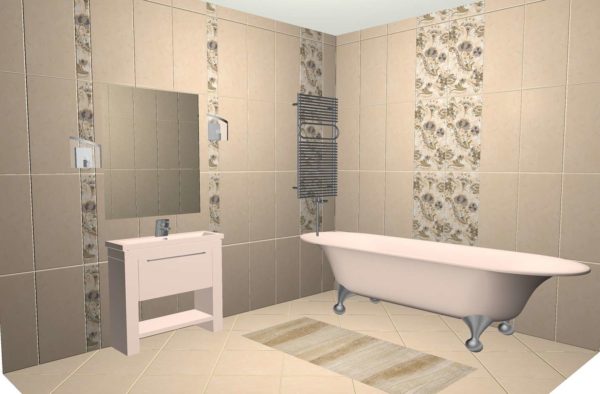 Correct use of tile decor in the bathroom.
Correct use of tile decor in the bathroom.
Tile format and laying scheme
In a small room, large tiles are inappropriate, but excessively small elements will also not give the effect of increasing the space. The long side of the tile should not exceed 25 cm.

If there is no need to visually expand the walls or raise the ceiling, you can decorate the room with square tiles, placing them in even rows. Half-offset brick layout visually reduces wall space. Rectangular tiles arranged in vertical rows will help to visually raise the ceiling. In a cramped room with high ceilings, tiles of this format are best glued horizontally to expand the walls. It is recommended to lay the floor tiles in a small bathroom diagonally in order to "push apart" the walls.

When buying the material, make sure that the ceramic tiles have smooth edges without glaze sags, corners without defects - only in this case, the seams will be minimal when laying end-to-end.

In a small room, it is best to avoid wide seams made with standard “crosses”. The smaller the gap between the tiles, the better - this avoids visual crushing of the plane into small fragments. For the same reason, the grout is selected to match the tile, and not contrasting.

Required number of wall tiles
The first way
To determine how many bathroom tiles are needed for wall cladding, we calculate the perimeter of the room. To do this, we summarize the lengths of all its walls. If we are talking about a standard bathroom, just add the length and width and multiply by 2. In our example: (1.8 + 1.7) * 2 = 7 m.
The required number of friezes is calculated based on the perimeter. To do this, the width of the door is subtracted from the perimeter of the bathroom. The resulting value is divided by the length of the frieze or border, respectively.
As an example, we will assume that we will decorate the walls with the main tiles 20 cm by 40 cm.The size of the frieze is 20 cm by 8 cm.In this case, to decorate the bathroom, we will need to purchase: (7-0.6) / 0.2 = 32 friezes.
To calculate the required amount of the main tile, you need to decide how it will be laid. If the walls will be decorated with dark and light tiles, you need to know exactly the height of the dark bottom.
If you wish, you can save money if you do not veneer the part of the wall located under the bathroom.In this case, it will be necessary to subtract the area in this area from the general calculations.
So, for example, assuming that the dark tile will be laid to a height of 1 m, we get that the height of the light top will be: 2.7 m -1 m - 0.08 m (frieze height) = 1.62 m. Now you can calculate the required number of tiles. For this:
- We calculate the area that the light and dark tiles will occupy.
- We divide the obtained values by the area of one tile.
- Round up to a larger integer value.
- We increase it by 5%.
- Round to the nearest whole value.
Our example will require:
- Dark tiles: (7-0.6) * 1 / (0.2 * 0.4) = 52.5 pcs 53 pcs * 1.05 = 55.56Þ56 pcs.;
- Light tiles: (7-0.6) * 1.62 / (0.2 * 0.4) = 55.05 pcs 56 pcs * 1.05 = 90.3Þ91 pcs.
If decorative inserts are planned, then the number of light or dark tiles should be reduced by the amount of decor purchased.
Second way
In this case, we lay out each wall in order to understand how many tiles can be placed in the horizontal and vertical rows. In this case, the tiles that need to be cut are taken into account as whole. We increase the resulting value by 5% to insure ourselves in case of marriage or battle. We count the required amount of dark, light tiles and borders and go shopping.
Unfolding the walls
Thus, knowing the above methods, everyone can independently calculate how many tiles are needed for the bathroom. You just need to correctly measure, decide on the type of tile, as well as how it will be located on the wall and floor.
Assortment of tiles
 Bicottura
Bicottura
When planning to buy a tile for a bathroom, you must first familiarize yourself with its varieties. So, ceramic tiles, depending on the manufacturing method, are divided into the following types:
- Bikottura. It is fired twice and covered with glaze. Despite its high resistance to aggressive detergents, it has a reduced strength. However, this is a great option for wall decoration.
- Monocotture. During production, the workpiece is fired 1 time. The result is a highly durable material that can be laid on the floor.
- Clinker. This is a common variant of ceramic tiles. In the production process, innovative technologies are used that make it possible to obtain a low-porous and durable material. At the same time, there is only one insignificant drawback - limited design: only natural shades are present.
- Porcelain stoneware. Heavy-duty floor tiles are highly resistant to abrasion and scratches. In most cases, porcelain stoneware manufacturers create imitations of natural stone: granite or marble. In addition, there is a rough surface, which gives the tiles a great resemblance to the original.
 Ceramic tiles on the floor
Ceramic tiles on the floor
Despite the fact that most often consumers prefer ceramic tiles, there are other varieties:
- Glass and mirror. Moisture resistance and durability are as high as those of ceramics. At the same time, the disadvantage is the susceptibility to shock loads. Therefore, walls and ceilings are trimmed with it.
- Polymeric. This is one of the most affordable options that everyone can afford to buy. A conscientious manufacturer offers its customers tiles in a variety of designs.
- A natural stone. The most expensive material is real stone. Thanks to modern equipment, it is possible to accurately cut the stone and carry out its processing to the standard tile sizes.
 Glass
Glass
Nuances of choice
The choice in color, size and shape is very wide and here they are based only on their own "I want" and "like", but at the same time, technical parameters and quality indicators must also be monitored:
In the bathroom, changes in temperature and humidity are commonplace, so you need to choose a moisture-resistant tile. The characteristics describe mainly water absorption. This is the amount of moisture that tiles can absorb. It is indicated as a percentage.For floor tiles, this figure cannot be higher than 3%, for wall tiles it can be higher, but the lower the better. Moisture-resistant tiles are characterized by a dense, low-porous base. In addition, such a material has a reduced conductivity, which is not at all superfluous in a room where there is both water and electrical appliances.
Since the walls and floor will have to be periodically washed with detergents, and they are chemically active, it makes sense to buy a material that is resistant to chemistry. Especially often this procedure is carried out in shared bathrooms - to maintain hygiene at the proper level. In this case, we choose the finishing material that is most resistant to the effects of chemicals. This characteristic is usually displayed on the label with a flask-shaped pictogram and adjacent Latin letters. For a bathroom, you can take B or A, and for a combined bathroom - AA (the highest level of durability).
The front surface of the tile has different abrasion resistance. This parameter is indicated by the letters PE and a number. The larger the number, the stronger the surface. Tiles in the bathroom on the walls are exposed to light loads, because the abrasion resistance may be small, but it is worth taking on the floor with PE 2 or 3.
For ceramic tiles, the front surface can be glossy or matte. On glossy traces of water are more visible (especially on dark)
So if the water is hard, it makes sense to choose matte.
When choosing floor tiles for the bathroom, pay attention to how slippery it will be when wet. This characteristic is also displayed on the label in the form of a pictogram and a number.
The numbers are wet friction coefficient. The higher the number, the less slippery the floor will be. On this basis, it is customary to divide it into four categories:
less than 0.19 - very slippery;
from 0.2 to 0.39 - slippery;
from 0.4 to 0.75 - acceptable;
above 0.75 - excellent performance.
Correctly selected bathroom tiles will last for years.
To keep it that way, pay attention to its technical characteristics. They are usually displayed as pictograms on the box.
If you know the decoding of all the icons, the choice will not be difficult. Those pictograms that are relevant for the selection of tiles in the bathroom are shown in the table.
| Image | Name | Comments (1) |
|---|---|---|
| Wall | Usually has lower abrasion resistance | |
| Outdoor | Denser and more abrasion resistant | |
| Resistant to chemicals | Bathroom tiles are exposed to hot chlorinated water, so this point will not be superfluous | |
| Tolshina | Thick ceramic tiles (5 mm to 9 mm) are placed on the floor, thinner tiles on the walls | |
| Abrasion resistance | Bathroom tiles are not exposed to heavy loads, therefore, its resistance can be PE1. | |
| Wet friction coefficient | Important when choosing floor tiles for the bathroom. The higher the ratio, the less slippery the floor will be. | |
| Tiles in the box may vary in color | The production technology is such that the tiles can have different colors. | |
| Number of tiles in a box | Convenient for calculation | |
| Square of tiles in a box | Convenient for calculation | |
| Weight of one box with tiles | May be needed during transportation |
We count the number of tiles for floor and wall cladding
Now about how to calculate the number of bathroom tiles to be laid on the floor. Everything is extremely simple here. Multiply the length of the room by its width. Calculate in meters.
The resulting figure will be the number of floor tiles in square meters.
In our case, this is 2 m × 2 m = 4 m² of floor tiles. In addition, add a few stocks as the tiles may break. And when pruning, it takes more.
Next, we find out how many tiles are needed for the bathroom, laid on the walls. This circumstance depends on how you want to cover them: whether you limit yourself to tiles that have one color, or you prefer a combination of two.
For clarity, let's take the ceiling height in the bathroom for 2.5 m.
If you have chosen one color, then the calculation formula is as follows:
- Sob. = (P × h) - SD.p., where symbols mean
- Sob.- the total area of the bathroom, in square meters;
- P is the perimeter of the room, in meters;
- h is the height of its walls, in meters;
- Sd.p. - the area of the doorway, in square meters.
For our example, this is Sv. = (8 m × 2.5 m) - 2.1 m × 0.6 m. We get 18.74 m².
Add another 5% / 10% of the tile to the resulting value, to take into account its inevitable trimming and battle.
If your choice fell on a two-color set, it is important what the dimensions of the ceramic bathroom tiles have. First determine the height of the bottom panel from the dark tile
In this case, how many tiles are needed for a dark-colored bathroom, we define as follows:
St. = (P × hт.), Where symbols
- St. - the area of the room trimmed with dark tiles, in square meters;
- P is its perimeter, in meters;
- hт. - the height of the walls of the room, which is faced with a dark color, in meters.
Having made the calculations, we get: St. = 8 m × 0.9 m. In other words - 7.2 m².
Subtract the area of the bottom of the door from this value:
- Sd.p.t. = ld.p. × ht., Where the letters mean:
- ld.p. - the width of the doorway, in meters;
- hт. - the height of the wall sections, trimmed with dark tiles, in meters.
The final formula for calculating the bathroom tiles below is:
St. = (P × ht.) - Sd.c.t. In practice, it looks like this: St. = (8 m × 0.9 m) - 0.6 m × 0.9 m. We get the final figure of 6.66 m²
Next, determine the amount of light colored tiles you need to cover the top of your bathroom walls.
Already knowing the height of the dark part, it is quite easy to do this:
- hс. = h - hт., where symbols mean:
- hс. - the height of the light wall cladding, in meters;
- h is the total height of the walls, in meters;
- hт. - the height of the dark wall cladding, in meters.
Formula for calculating light tiles:
- Sс. = P × hс., Where the letters mean:
- P is the perimeter of the room, in meters;
- hс. - the height of the light part of the walls, in meters.
In other words: Sс. = 8 m × (2.5 m - 0.9 m). After making the calculations, we get 12.8 m² of light tiles.
> Do not forget to subtract the area at the top of the doorway from this value again.
Finally, the formula for calculating tiles in a light-colored bathroom looks like this:
Sс. = (P × hs.) - Sd.c.p.





